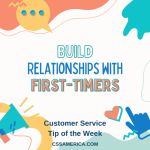 Depending on what industry that you work in, business is either booming, or it’s greatly slowed down. I’m not sure if there’s much of a middle ground these days – where industries are working as normal.
Depending on what industry that you work in, business is either booming, or it’s greatly slowed down. I’m not sure if there’s much of a middle ground these days – where industries are working as normal.
If you’re in one of the industries where business has slowed, there may be an opportunity for you, and a need to address. When customers are not coming to us as often – to take out a loan for a financial institution, to order products, to buy tickets to a sporting event, to submit plans for new construction – those are times where we lose touch points with our customers. Those are times when we lose contact. Those are times where there are gaps in the communication which can lead to relationships going stale.
Therefore, these are times when we need to ramp up our proactive communications with customers.
Three Types of Proactive Touches – Pick the Right Ones
Too often, businesses view proactive touch points with customers only as opportunities to market and sell. However, you may recall that we recommend three different types of touch points with customers. One obviously is a proactive communication where you’re marketing and selling, but the first touch point is one where you are seeking information from your customers, asking questions, conducting short surveys, or inquiring about the customer. The second is actually a proactive push of information, but it is not sales and marketing-oriented. Instead, you are sharing information of value. You’re trying to help the customer. You are offering educational information to help them personally or professionally.
So, two of the three proactive touches have nothing to do with marketing and sales, and these softer touches are the ones to ramp up at times like these.
When the number of times that your customer reaches out to you goes down, ramp up the number of proactive touches to your customers. But with empathy, remember that these touches are focused on learning about them and how they’re doing; these touches are about providing information valuable to them – to help them.
Keep your proactive communications with your customers going.
Don’t let relationships go stale.
Signup for FREE Tips! Contact Us More Resources for You Visit Our Home Page














 “I just want to be heard.”
“I just want to be heard.” We work with a lot of educational organizations, but this Tip of the Week applies to virtually any kind of business that has repeat customers. To deliver great service, be willing to go above and beyond, do virtually anything for the customer. But in the world of colleges and universities, most of those organizations of higher education also have the mindset that they have to help their students grow, mature, develop over their time in school. It’s important to put the responsibility and the resulting accountability on the student so that they take ownership over the action, and they can do it on their own in the future. By helping them to develop some independence, in the long run it is actually saving time for the university personnel as well.
We work with a lot of educational organizations, but this Tip of the Week applies to virtually any kind of business that has repeat customers. To deliver great service, be willing to go above and beyond, do virtually anything for the customer. But in the world of colleges and universities, most of those organizations of higher education also have the mindset that they have to help their students grow, mature, develop over their time in school. It’s important to put the responsibility and the resulting accountability on the student so that they take ownership over the action, and they can do it on their own in the future. By helping them to develop some independence, in the long run it is actually saving time for the university personnel as well.






